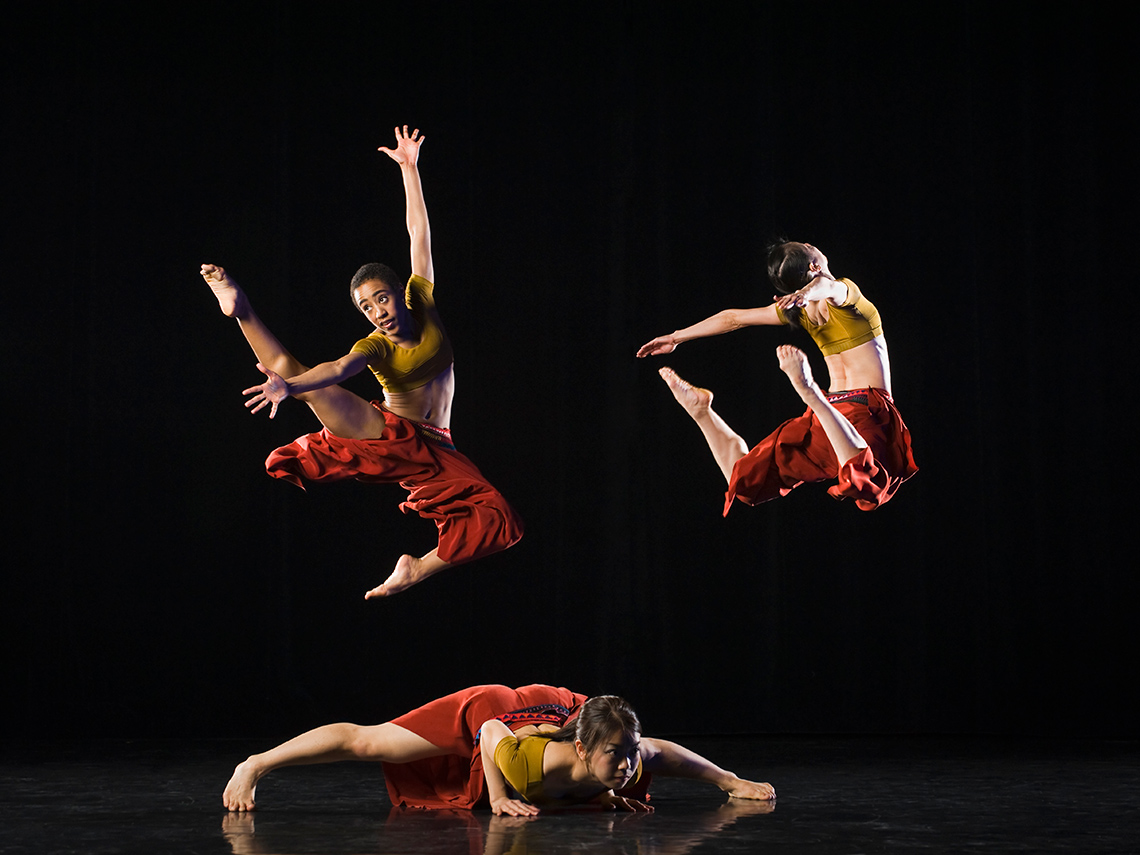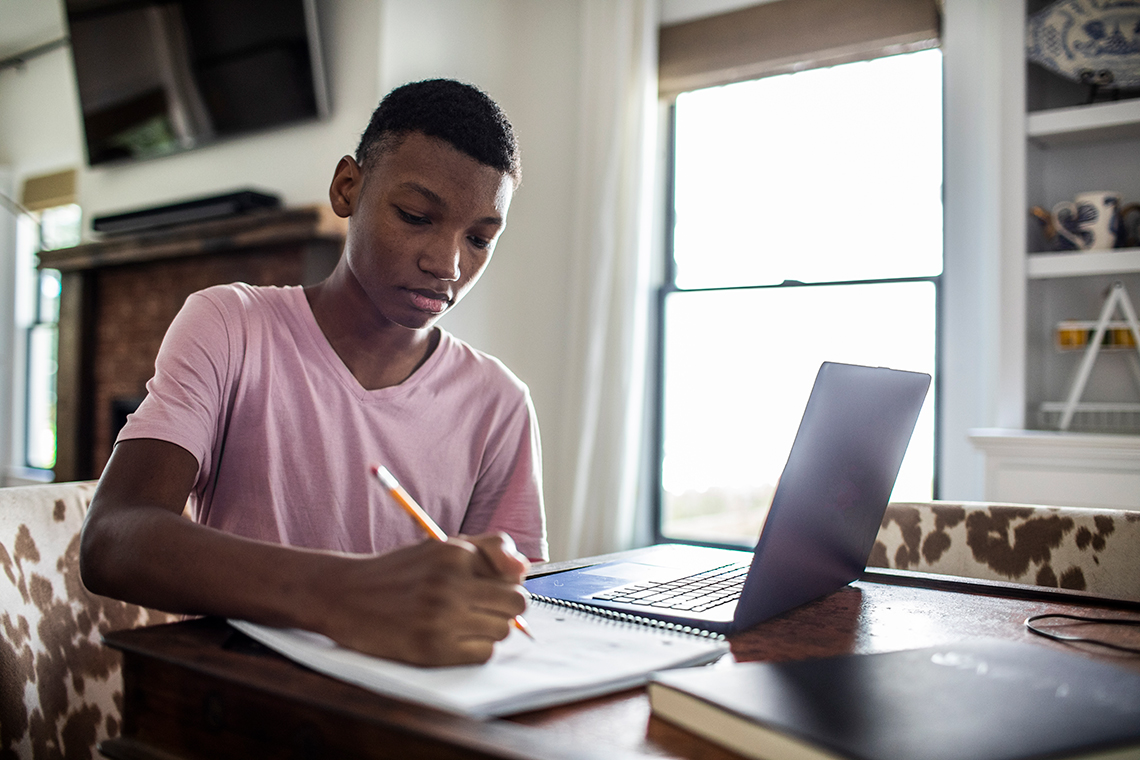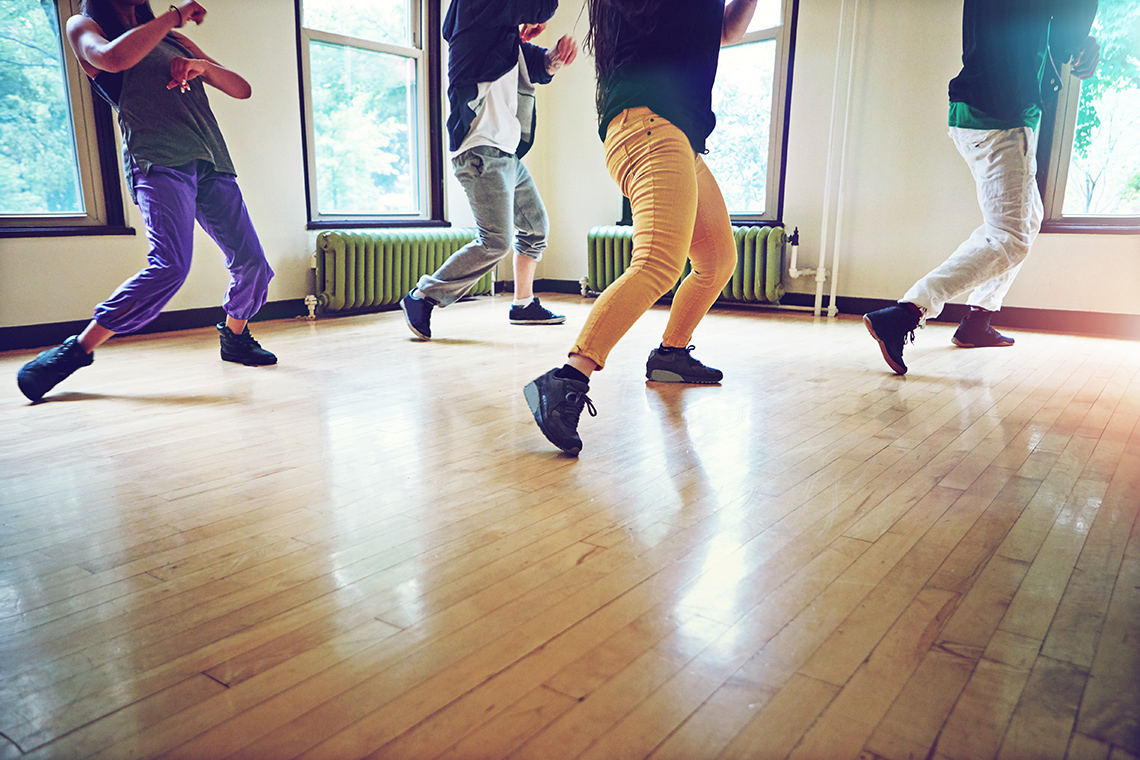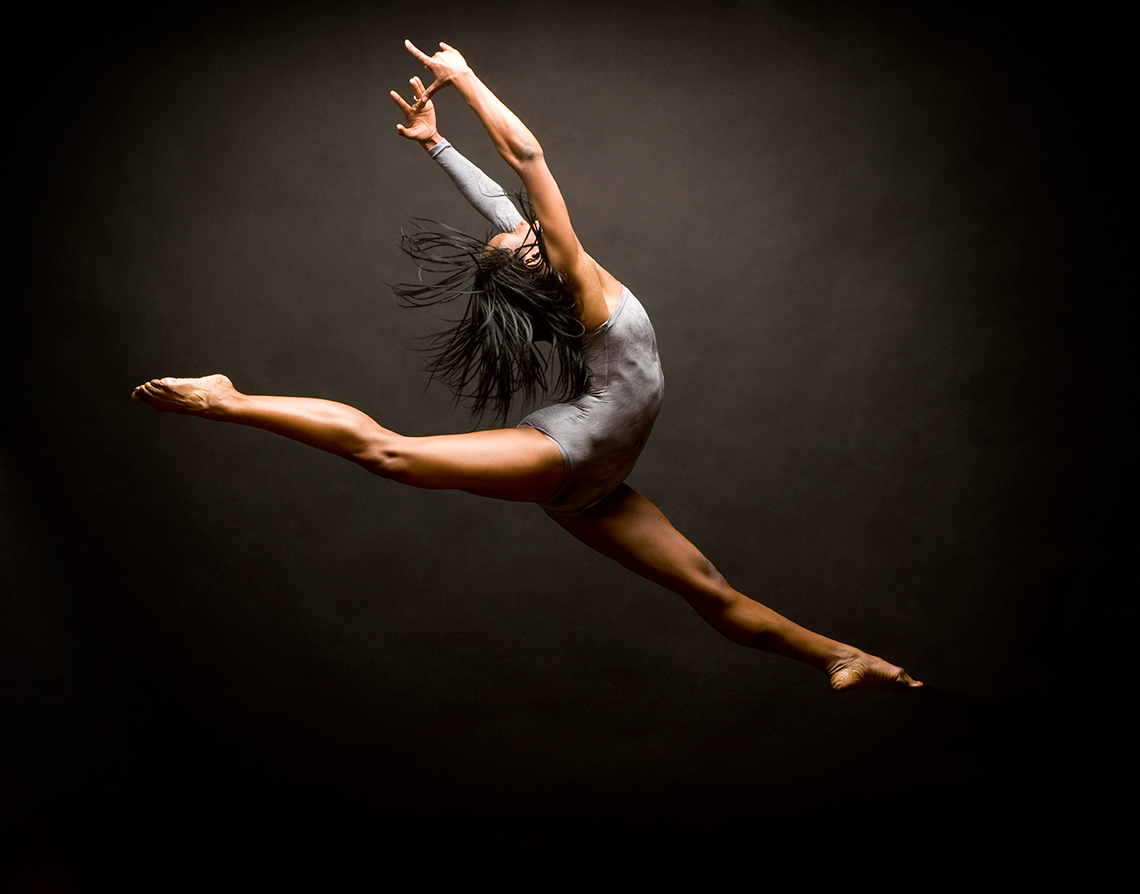Minds On
Today’s vocabulary
Press the following tabs to access definitions of terms we will be using today.
Important ideas in dance, which include the following:
- Body: The instrument of dance. The term body may also refer to the body’s position or shape (e.g., curved, straight, angular, twisted, symmetrical, asymmetrical); also, how the body is moving (e.g., using locomotor or non-locomotor movements).
- Energy: The force with which the body moves (e.g., light, strong, sustained, sudden).
- Relationship: The way in which two or more things are connected to or associated with one another (e.g., dancer to dancer, dancer to object, or right arm to left arm).
- Space: The physical area in which the body moves; also, the area surrounding the body.
- Time: An element of dance involving rhythm, tempo, accent, and duration. Time can be based on measured beats, as in music, or on body rhythms, such as breath, emotions, and heartbeat.

Let’s get started!
Dance can be a powerful way to communicate messages of social justice to the audience. The following are several examples of dance pieces that use the elements of dance to explore a social justice issue. Select one example you would like to explore further.
Content warning
While the content in this learning activity is aligned to the curriculum, some content may be sensitive to individual learners. Consider reaching out to a trusted adult to share your feelings and questions.
Option 1
Access this video to learn more about Mia Michael’s choreography about addiction, featuring Kayla and Kapuno from the television show So You Think You Can Dance.
DescriptionIn this clip, Kapuno is standing facing the audience, Kayla is at his left side, with her body turned towards him. He has his left arm around her. Kapuno brings his right arm up in front of his body making a wavy pathway in the air. Kayla mirrors the movements he makes with his arm with her body, slowly bending backward until her upper body is horizontal and the weight of her body is resting on Kapunos left arm. He brings his right arm up and over her body. He lifts his arm up into the air twice and she mirrors the movement with her body coming up with his arm as if being pulled by a string.
Kayla then stands upright so they are face to face, their bodies close together, in profile to the audience. Kayla’s arms stretch out to the side and then she falls forward, embracing Kapuno and he holds her around the waist and spins across the stage with her. As he turns, her body shifts, so she is now facing out towards the audience. Holding Kayla under the arms, Kapuno spins around again, lifting her body up off the ground as they turn. They land and Kayla is now facing the audience with Kapuno standing directly in front of her. She is standing on the balls of her feet, balancing, arms hanging out in front of her. From behind her, Kapuno raises his right arm and then his left. She mirrors these movements as if she is a puppet and he is controlling her body. He then grabs her with one arm around her waist and one arm behind her leg, forcing her leg up towards her face, and drags her backward across the stage.
Option 2
Check out this video with Jade Jager Clark’s choreography about mental health, featuring dancers from Jade’s Hip Hop Academy.
DescriptionA dancer wearing all black sits centre stage on a riser. Seven other dancers, wearing brightly coloured clothes enter from both sides and join the dancer in black on the risers. They sit around the dancer in black and mime having a conversation. Then all the dancers turn to face the front. They are sitting or standing together in a clump on the risers.
The dancer in black is in the centre. The dancer in black brings her arms up as if shrugging her shoulders, then brings her arms out to the side and all dancers circle their upper bodies around in a clockwise direction. The dancer in black then raises her arms up and crosses them in front of her, as if to say no. She then brings her right hand up in front of her, then her left hand then clasps them in front of her and steps up onto the black box in the front of the cluster. The dancers in the colourful outfits are all looking away from the dancer in black. The dancer in black then brings her hands down, clutches her chest, and steps backward into the centre of the dancers in colourful outfits. The dancers in colourful outfits turn and follow the dancer in black’s movements with their hands as if pushing her back into the centre of the circle.
Option 3
Explore this video excerpt from the 2019 Tina Phelps’ dance show, about the climate crisis.
DescriptionThe stage is dark and shadowy. There of stairs up centre stage. The image of the earth is projected on the cyclorama (white screen at the back of the stage). There are eight dancers on stage. They are wearing neutral-coloured bodysuits with skirts. At the start of the clip, they are all doing their own movements, scattered across the stage. Many of them are dancing at low levels or on the ground. Slowly, they all begin to rise until they are all standing, facing the audience, in a neutral position, arms at their sides.
One dancer comes to the centre and raises her arms up over her head and crosses them at the wrists. She then slowly uncrosses them and brings them down to her sides as the other dancers sway gently back and forth. The camera zooms in on this dancer in the centre as she turns her body slightly, so her right side is facing the audience. She brings her right arm around in a circle quickly and steps forward on her right foot. She then brings both arms out to the side and spins toward the left side of the screen (stage right). As she comes out of the turn, she jumps, lands on both feet, and swings her arms backward in a circle. She then pushes her right arm out forcefully towards the audience. As she does this, her body contracts, and she sinks down to a medium level.

A student saying “There is no right or wrong answer! Your initial reaction is just your first impression of the dance. This may change over time as you continue to revisit and analyze the piece.”
Action
Get ready, get set…

Task 1: Description
Revisit the dance piece you selected in the Minds On section.
Using dance vocabulary, where possible, describe how the dancers used the elements of dance to communicate the theme or message of their piece.
Press the following tab to access elements of dance chart.
|
Body |
What is your body doing? Consider the following questions: What different body bases could you use to create a shape with your body? What different body parts could you move? How many different locomotor and non-locomotor movement could you create? Could you create symmetry in your body? What about asymmetry? What kinds of angular shapes could you make? What kind of curved shapes could you make? |
|
Space |
Where is your body moving? Consider the following questions: How could you move at a high, middle, or low level? What different pathways could you travel (in a straight line, in a zigzag, backwards)? If you are dancing with someone else, how is it different when you dance close together vs. far apart? |
|
Time |
When is the body moving? (in relation to time) Consider the following questions: How could you move at various speeds (e.g., fast, medium, slow)? How is it different dancing to music vs. dancing without music? Could you add a pause or a moment of stillness into your movements? |
|
Energy |
How is the body moving? Consider the following questions: How could you move lightly (e.g., as if you are a balloon floating through the sky, as if you are an astronaut in outer space? How could you move as if your body was heavy (e.g., as if you were pushing a big piece of furniture across the floor, as if you were moving through thick mud)? What is an example of a sudden movement? What is an example of a sustained movement? |
|
Relationship |
Who or what is the body moving with? Consider the following questions: How might dancers meet or part in a dance piece? How could emotions or facial expressions be added to movements? How could you move around, under, or over a prop? |
Record your ideas using the last column in the appropriate graphic organizer or use a method of your choice.
Graphic organizer for option 1
Complete the Option 1 Organizer in your notebook or using the following fillable and printable document. If you would like, you can use speech-to-text or audio recording tools to record your thoughts. Consider adding your work to your dance portfolio.
|
Dance Piece I Chose: Mia Micheal’s choreography about addiction Theme or Message of the Piece: it’s difficult to break an addiction |
||
|---|---|---|
|
Describe examples from the dance piece: |
||
|
Body |
e.g., isolation of body parts during the section where Kapuno was controlling Kayla’s arms as if she were the puppet |
|
|
Space |
e.g., dancers are very close together. Kapuno often in Kayla’s negative space |
|
|
Time |
e.g., slow movements, connection to music |
|
|
Energy |
e.g., use of sustained and bound movements |
|
|
Relationship |
e.g., the relationship between the two dancers and the sense of Kapuno’s body controlling Kayla’s movements |
|
|
Additional tools such as costumes, props, lighting, and sound |
e.g., Kapuno wearing dark colours to represent the addiction |
|
Press the ‘Activity’ button to access Option 1 Organizer.
Graphic organizer for option 2
Complete the Option 2 Organizer in your notebook or using the following fillable and printable document. If you would like, you can use speech-to-text or audio recording tools to record your thoughts. Consider adding your work to your dance portfolio.
|
Dance Piece I Chose: Jade Jager Clark’s piece about mental health Theme or Message of the Piece: having mental health issues can interfere with your friendships and social interactions |
||
|---|---|---|
|
Describe examples from the dance piece: |
||
|
Body |
e.g., use of almost entirely non-locomotor movements |
|
|
Space |
e.g., grouping of dancers in the coloured shirts around the dancer in black |
|
|
Time |
e.g., dancing to the music used in the piece |
|
|
Energy |
e.g., sharp, articulated movements of dancer in black |
|
|
Relationship |
e.g., the dancer in black doing solo movements vs. The dancers in coloured shirts moving in unison |
|
|
Additional tools such as costumes, props, lighting, and sound |
e.g., the use of black vs. coloured costumes |
|
Press the ‘Activity’ button to access Option 2 Organizer.
Graphic organizer for option 3
Complete the Option 3 Organizer in your notebook or using the following fillable and printable document. If you would like, you can use speech-to-text or audio recording tools to record your thoughts. Consider adding your work to your dance portfolio.
|
Dance Piece I Chose: Tina Phelps’ piece about the climate crisis Theme or Message of the Piece: Now is the time to act to combat climate change |
||
|---|---|---|
|
Describe examples from the dance piece: |
||
|
Body |
e.g., the use of the body contraction at the end of the piece |
|
|
Space |
e.g., the dancers on the ground at a low level at the beginning of the piece |
|
|
Time |
e.g., the contrast of the solo dancer slowly brings her arms down from a crossed position vs. Her quick turn and jump |
|
|
Energy |
e.g., the shape direct “push” movement at the end of the piece |
|
|
Relationship |
e.g., the use of unison vs. Solo dancer |
|
|
Additional tools such as costumes, props, lighting and sound |
e.g., the voice-over narration |
|
Press the ‘Activity’ button to access Option 3 Organizer.
Go!
Task 2: Analyzing the dance piece

Revisit the dance piece you chose again.
Revisit your description of how the piece used the elements of dance. Consider how the elements of dance helped to communicate the theme or message of the piece. Record your ideas in the right column in the appropriate graphic organizer or use a method of your choice.
Graphic organizer for option 1, the dance about addiction
Complete the Option 1 Message in your notebook or using the following fillable and printable document. If you would like, you can use speech-to-text or audio recording tools to record your thoughts. Consider adding your work to your dance portfolio.
|
Dance Piece I Chose: Mia Micheal’s choreography about addiction Theme or Message of the Piece: it’s difficult to break an addiction |
||
|---|---|---|
|
Describe examples from the dance piece: |
How it helps communicate the theme or message: |
|
|
Body |
e.g., isolation of body parts during the section where Kapuno was controlling Kayla’s arms as if she were the puppet |
e.g., it demonstrates the control the Kapuno “the addiction” has over her body |
|
Space |
e.g., dancers are very close together. Kapuno often in Kayla’s negative space |
e.g., helps to demonstrate that she can’t escape the addiction |
|
Time |
e.g., slow movements, connection to music |
|
|
Energy |
e.g., use of sustained and bound movements |
|
|
Relationship |
e.g., the relationship between the two dancers and the sense of Kapuno’s body controlling Kayla’s movements |
|
|
Additional tools such as costumes, props, lighting, and sound |
e.g., Kapuno wearing dark colours to represent the addiction |
|
Press the ‘Activity’ button to access Option 1 Message.
Graphic organizer for option 2, the dance about mental health
Complete the Option 2 Message in your notebook or using the following fillable and printable document. If you would like, you can use speech-to-text or audio recording tools to record your thoughts. Consider adding your work to your dance portfolio.
|
Dance Piece I Chose: Jade Jager Clark’s piece about mental health Theme or Message of the Piece: having mental health issues can interfere with your friendships and social interactions |
||
|---|---|---|
|
Describe examples from the dance piece: |
How it helps communicate the theme or message: |
|
|
Body |
e.g., use of almost entirely non-locomotor movements |
e.g., the dancer in black is “stuck” and is having a hard time engaging socially because of her anxiety |
|
Space |
e.g., the grouping of dancers in the coloured shirts around the dancer in black |
e.g., helps the audience to see that the dancer in black feels trapped |
|
Time |
e.g., dancing to the music used in the piece |
|
|
Energy |
e.g., the sharp, articulated movements of the dancer in black |
|
|
Relationship |
e.g., the dancer in black doing solo movements vs. the dancers in coloured shirts moving in unison |
|
|
Additional tools such as costumes, props, lighting, and sound |
e.g., the use of black vs. coloured costumes |
|
Press the ‘Activity’ button to access Option 2 Message.
Graphic organizer for option 3, the dance about climate change
Complete the Option 3 Message in your notebook or using the following fillable and printable document. If you would like, you can use speech-to-text or audio recording tools to record your thoughts. Consider adding your work to your dance portfolio.
|
Dance Piece I Chose: Tina Phelps’ piece about the climate crisis Theme or Message of the Piece: Now is the time to act to combat climate change |
||
|---|---|---|
|
Describe examples from the dance piece: |
How it helps communicate the theme or message: |
|
|
Body |
e.g., the use of the body contraction at the end of the piece |
e.g., that was a gesture towards the audience, encouraging them to act now! |
|
Space |
e.g., the dancers on the ground at a low level at the beginning of the piece |
e.g., communicated the idea of “rising up” and that now is the time to stand up and act |
|
Time |
e.g., the contrast of the solo dancer slowly brings her arms down from a crossed position vs. Her quick turn and jump |
|
|
Energy |
e.g., the shape direct “push” movement at the end of the piece |
|
|
Relationship |
e.g., the use of unison vs. Solo dancer |
|
|
Additional tools such as costumes, props, lighting, and sound |
e.g., the voice-over narration |
|
Press the ‘Activity’ button to access Option 3 Message.
Task 3: Considering of cultural context
Consider the following questions:
- What do you know about the topic your chosen dance piece is about?
- What do you think society’s perspective of this issue might be?
- What’s your perspective of the issue?
- Why do you think this issue is relevant or important?
- How might reflecting on these questions inform your thinking about the dance piece?
- Is there anything you would add or change in your previous analysis of the dance?
Record your ideas using a method of your choice.

Consolidation
Putting it all together

Portfolio
Review your learning
Use the following questions to reflect on your learning. Consider adding your answers to the reflection questions to your portfolio.
- In what ways can dance be a powerful medium for communicating ideas about social justice? Explain your thinking?
- What aspect of the dance do you think was the most important in communicating the message to the audience?
- How can analyzing dance improve your skills as a dancer and choreographer?
Record your responses using a method of your choice.
Reflection
As you read the following descriptions, select the one that best describes your current understanding of the learning in this activity. Press the corresponding button once you have made your choice.
I feel…
Now, expand on your ideas by recording your thoughts using a voice recorder, speech-to-text, or writing tool.
When you review your notes on this learning activity later, reflect on whether you would select a different description based on your further review of the material in this learning activity.
Discover MoreRevisit a dance piece you have created previously.
- How does your use of the elements of dance compare to the piece you explore here?
- Are there similarities in the ways the elements of dance were used?
- Was there anything you learned from your analysis here that you might apply to your dance work in the future?